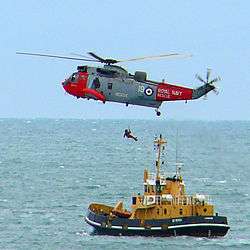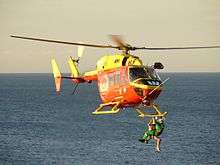Water safety
Water safety is the procedures, precautions and policies associated with safety in, on and around bodies of water, where there is a risk of injury or drowning. It has applications in several occupations, sports and recreational activities.[1][2]
Scope
Beach safety
River safety
Swimming pool safety
Associated industries
Manufacture of marine and aquatic safety equipment
Associated occupations
Air-sea rescue


Air-sea rescue (ASR or A/SR, also known as sea-air rescue [3]) is the coordinated search and rescue (SAR) of the survivors of emergency water landings and people who have survived the loss of their seagoing vessel or are otherwise in peril at sea. ASR can involve a wide variety of resources including seaplanes, helicopters, submarines, rescue boats and ships. Specialized equipment and techniques have been developed. Military and civilian units can perform air-sea rescue.
Air-sea rescue operations carried out during war have saved valuable trained and experienced airmen.[4] Moreover, the knowledge that such operations are being carried out greatly enhanced the morale of the combat aircrew faced not only with the expected hostile reaction of the enemy but with the possible danger of aircraft malfunction during long overwater flights.[4]
Lifeboat service
A rescue lifeboat is a rescue craft which is used to attend a vessel in distress, or its survivors, to rescue crew and passengers. It can be hand pulled, sail powered or powered by an engine. Lifeboats may be rigid, inflatable or rigid-inflatable combination hulled vessels.
There are generally three types of boat, inland (used on lakes and rivers), inshore (used in coastal waters) and offshore (into deeper waters and further out to sea). A rescue lifeboat is a boat designed with specialised features for searching for and rescuing people in peril at sea or in estuaries. Where practicable, lifeboats will usually perform minor salvage and towing operations to assist mariners in distress and prevent navigational hazards.
Water safety organisations
There are a large number of government and non-government bodies in the field of water safety, including maritime search and rescue organisations, lifeguard associations, and other safety organisations for which water safety is just part of their scope.[2][1][5] [6]
See also
References
- 1 2 Staff. "Drowning and Water Safety". Water & Leisure Safety. The Royal Society for the Prevention of Accidents. Retrieved 2 February 2017.
- 1 2 Staff. "Water Safety". Types of emergencies. American red cross. Retrieved 2 February 2017.
- ↑ Cutler, Deborah W.; Cutler, Thomas J.; Wedertz, Bill (2005). Dictionary of naval abbreviations. 23. Naval Institute Press. pp. 36, 384. ISBN 1-59114-152-4.
- 1 2 Marion, Forrest L. (Spring 2004). "Bombers and boats: SB-17 and SB-29 combat operations in Korea". Air Power History. 51.
- ↑ Staff. "Vision and Mission". About us. Wellington, New Zealand: Water Safety New Zealand. Retrieved 2 February 2017.
- ↑ Staff. "Who We Are". Water Safety USA. Water Safety USA. Retrieved 2 February 2017.